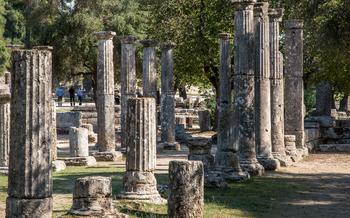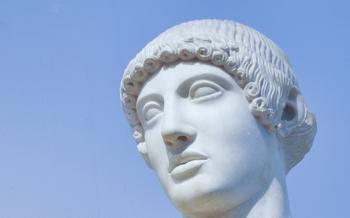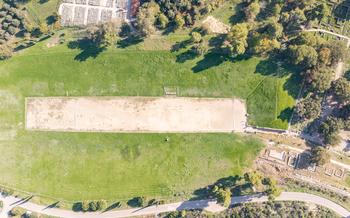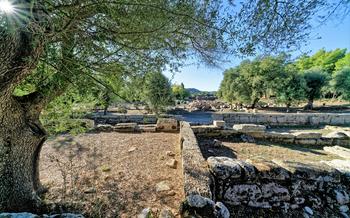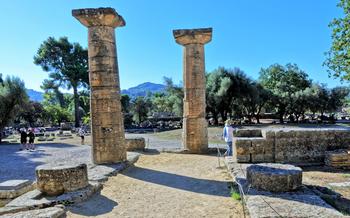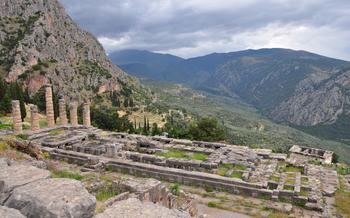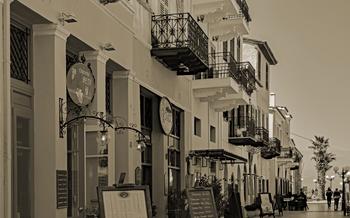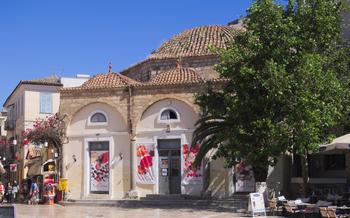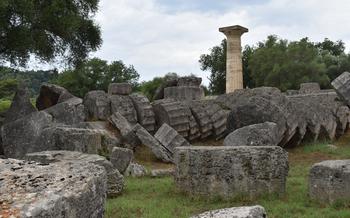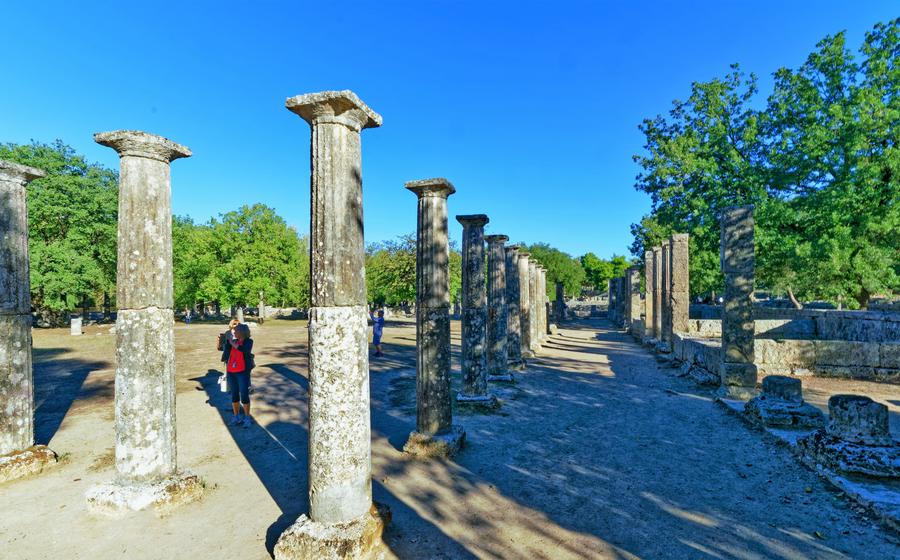
Vasses (Ancient Bassae)
- Olympia: Antiquity's Cornerstone
- Vasses: The Hidden City of Arcadia
- Temple of Apollo Epicurius: A Masterpiece in Motion
- A Journey Through Time: Exploring the Archaeological Site
- The Temple's Restoration: A Labor of Love
- A UNESCO World Heritage Site: Preserving Ancient Treasures
- The Temple's Influence on Modern Architecture
- Excavations and Discoveries: Unveiling Bassae's Secrets
- Festivals and Events: Celebrating Bassae's Heritage
- Local Cuisine and Hospitality: A Taste of Arcadia
- Getting to Bassae: A Journey Through the Peloponnese
- Accommodation Options: Resting in the Heart of Arcadia
- Practical Tips for Visitors: Ensuring a Smooth Journey
- Insider Tip: Discover Hidden Gems Beyond Bassae
Olympia: Antiquity's Cornerstone
Olympia, a sacred sanctuary in ancient Greece, holds a pivotal place in history as the birthplace of the Olympic Games. These ancient athletic competitions, steeped in mythology and religious rituals, transcended mere sports and represented a profound cultural and spiritual expression. The games commenced in 776 BC and continued for over a millennium, embodying the ideals of excellence, competition, and harmony. Olympia's archaeological site, a UNESCO World Heritage Site, offers a glimpse into this glorious past, with remnants of temples, athletic facilities, and treasuries that evoke the grandeur of the ancient games. Visitors can explore the site's museum, housing a treasure trove of artifacts, including the iconic statue of Hermes by Praxiteles. A visit to Olympia is a journey through time, immersing travelers in the origins of Western civilization and the legacy of the Olympic spirit.
Practical Information
- Ticket Prices: Standard admission: €12; Reduced admission (students and seniors): €6
- Hours of Operation: Summer (April-October): 8am-8pm; Winter (November-March): 8am-5pm
- Recommended Tour Guides: Accredited guides are available for hire at the site's entrance, offering insightful commentary and historical context.
Vasses: The Hidden City of Arcadia
In the heart of the Peloponnese, nestled amidst the verdant hills of Arcadia, lies the ancient city of Bassae, a hidden gem waiting to be discovered. Steeped in history and mythology, Bassae is renowned for its remarkably preserved Temple of Apollo Epicurius, a testament to the architectural prowess of ancient Greece.
Bassae's strategic location on the slopes of Mount Kotilion offered both defensive advantages and breathtaking views of the surrounding landscape. The city's origins date back to the 6th century BC, when it served as a religious and cultural center for the Arcadian region. Its prominence grew significantly during the 5th century BC, coinciding with the construction of the Temple of Apollo Epicurius, which became a symbol of Bassae's prosperity and devotion to the Olympian gods.
Despite its historical significance, Bassae remained relatively unknown to the outside world until the 18th century when European travelers and archaeologists rediscovered its ruins. Excavations conducted in the 19th and 20th centuries further revealed the city's rich past, shedding light on its urban layout, fortifications, and everyday life.
Today, visitors to Bassae can wander among the ruins of this ancient city, marveling at the architectural marvels that have stood the test of time. The Temple of Apollo Epicurius remains the centerpiece of the site, attracting travelers from around the globe with its exquisite design and well-preserved sculptures.
As you explore Bassae, be sure to take in the stunning panoramic views from the temple's hilltop perch. The surrounding landscape, dotted with rolling hills, olive groves, and distant mountains, creates a picturesque backdrop for this archaeological treasure.
To capture the essence of Bassae's beauty, plan your visit during the golden hours of sunrise or sunset. The warm hues of the setting sun cast a magical glow on the temple's columns, transforming it into a breathtaking sight that will linger in your memory long after your visit.
Temple of Apollo Epicurius: A Masterpiece in Motion
The Temple of Apollo Epicurius, nestled amidst the rugged beauty of Arcadia, stands as a testament to ancient Greek architectural prowess. Its construction, meticulously orchestrated during the 5th century BCE, involved skilled craftsmen and architects who left an indelible mark on history. The temple's Doric order, characterized by its simplicity and strength, is a hallmark of its design. Majestic columns, adorned with delicate fluting, rise towards the heavens, supporting a sturdy entablature.
The pediments, intricately carved with mythological scenes, depict tales of gods and heroes, bringing ancient legends to life. The eastern pediment showcases a battle between the Lapiths and Centaurs, while the western one portrays the struggle between Apollo and Hercules for the possession of the Delphic tripod. These sculptures, remarkably preserved despite the passage of time, offer a glimpse into the vibrant storytelling traditions of ancient Greece.
The temple's location atop a hill, overlooking the surrounding landscape, is not merely a coincidence. The architects carefully aligned the temple with the stars, creating a celestial connection that was both symbolic and practical. During the summer solstice, the first rays of sunlight illuminate the temple's interior, casting a mystical glow upon the sacred space within. This alignment not only demonstrated the Greeks' understanding of astronomy but also reinforced the temple's spiritual significance.
A Journey Through Time: Exploring the Archaeological Site
The archaeological site of Bassae, nestled amidst the picturesque hills of Arcadia, offers a captivating glimpse into the ancient city's vibrant past. As you step through its boundaries, you are greeted by an array of ruins and remnants that tell the story of Bassae's daily life.
Stroll along the remnants of ancient streets, lined with foundations of houses and shops, and imagine the bustling activity that once filled these spaces. Discover the ruins of a theater, where performances and gatherings took place, echoing with the laughter and applause of Bassae's inhabitants.
Among the most significant artifacts unearthed at the site are pottery fragments, coins, and inscriptions. These relics provide valuable insights into the economic activities, trade relations, and administrative practices of ancient Bassae. They offer a tangible connection to the people who lived here centuries ago, allowing us to piece together their stories and customs.
Navigating the archaeological site is relatively straightforward, with well-defined paths and informative signage guiding your exploration. Accessibility is well-considered, ensuring that visitors of all abilities can immerse themselves in the ancient wonders of Bassae.
The Temple's Restoration: A Labor of Love
Over the centuries, the Temple of Apollo Epicurius fell into disrepair due to natural elements and neglect. Its once-vibrant colors faded, and its sculptures suffered from erosion and damage. In the 19th century, the temple's significance gained recognition, prompting efforts to preserve and restore this ancient marvel.
A team of dedicated archaeologists and architects embarked on a meticulous restoration process that spanned several decades. They carefully studied the temple's original design and structure, using historical accounts, archaeological evidence, and architectural expertise to guide their work.
The challenges they faced were immense. The temple's remote location, perched atop a hill, made it difficult to transport materials and equipment. The intricate carvings and sculptures required painstaking restoration, involving techniques such as laser cleaning and stone conservation.
Through perseverance and expertise, the restoration team berhasil in bringing the temple back to its former glory. They reconstructed collapsed columns, repaired damaged sculptures, and restored the temple's vibrant colors using traditional pigments. Today, the Temple of Apollo Epicurius stands as a testament to the dedication and skill of those who worked tirelessly to preserve this ancient masterpiece.
A UNESCO World Heritage Site: Preserving Ancient Treasures
The Temple of Apollo Epicurius has been recognized as a UNESCO World Heritage Site, a prestigious designation that acknowledges its exceptional cultural and historical significance. To be designated as a World Heritage Site, a site must meet at least one of ten selection criteria established by UNESCO. The Temple of Apollo Epicurius erfüllt several of these criteria, including its outstanding universal value, its unique architectural features, and its exceptional testimony to a vanished civilization.
As a UNESCO World Heritage Site, the Temple of Apollo Epicurius receives increased recognition, protection, and funding for its preservation and maintenance. UNESCO's designation also raises awareness of the site's importance, encouraging international collaboration and cooperation in its conservation efforts. The local communities surrounding Bassae play a crucial role in preserving and promoting the site's heritage. They serve as custodians of the temple and its surrounding landscape, ensuring that future generations can continue to appreciate and learn from this remarkable ancient site.
The Temple's Influence on Modern Architecture
The Temple of Apollo Epicurius, with its innovative architectural features and refined aesthetics, has left an indelible mark on the world of architecture. Its Doric order, characterized by simple yet elegant columns, has served as inspiration for countless later buildings. The harmonious proportions and balanced composition of the temple have influenced neoclassical architecture, a style that emerged in the 18th century, drawing heavily on ancient Greek and Roman ideals.
During the 19th and 20th centuries, modern architects, such as Le Corbusier and Mies van der Rohe, were captivated by the temple's minimalist approach and functional design. They incorporated similar principles of simplicity, clean lines, and geometric forms into their own architectural creations. The temple's emphasis on symmetry and proportion has also influenced contemporary architecture, leading to the development of various architectural styles that prioritize clarity, order, and visual harmony.
The legacy of the Temple of Apollo Epicurius extends far beyond its physical structure. It embodies a spirit of innovation and aesthetic excellence that has shaped the evolution of architecture throughout history. Its influence can be seen in buildings across the globe, from classical mansions to modern skyscrapers, demonstrating the temple's enduring impact on the built environment.
Excavations and Discoveries: Unveiling Bassae's Secrets
Archaeological excavations at Bassae have played a pivotal role in uncovering the secrets of this ancient city. Systematic digs began in the late 19th century, revealing a wealth of artifacts, inscriptions, and structures that shed light on Bassae's history and culture.
Among the significant discoveries made during the excavations were numerous votive offerings, including terracotta figurines, bronze statuettes, and ceramic vessels. These offerings provide valuable insights into the religious practices and beliefs of the ancient inhabitants of Bassae.
Excavations also unearthed inscriptions that offer glimpses into the city's administration, economy, and social organization. These inscriptions include records of financial transactions, legal documents, and dedications to various deities.
The remains of several buildings, including houses, workshops, and public structures, have also been uncovered. These structures provide a tangible sense of the daily life and activities that took place in Bassae centuries ago.
Ongoing research and studies continue to deepen our understanding of Bassae's history and culture. Archaeologists and scholars are working to piece together the puzzle of this ancient city, using the excavated artifacts and evidence to reconstruct its past.
The excavations at Bassae have not only revealed the physical remains of the city but have also brought to light the rich cultural heritage and vibrant community that once thrived in this remote corner of Arcadia.
Festivals and Events: Celebrating Bassae's Heritage
Bassae, nestled in the heart of Arcadia, hosts a vibrant array of cultural events and festivals throughout the year, offering visitors a chance to immerse themselves in the rich traditions and customs of the region. These festivals showcase traditional Greek dances, music, and performances, providing a captivating glimpse into the local way of life.
One of the most popular events is the Bassae Festival, held annually in the summer months. This lively festival features traditional Greek music concerts, dance performances, and theatrical productions, all set against the backdrop of the ancient temple. The festival attracts visitors from all corners of the country and abroad, eager to experience the infectious energy and vibrant atmosphere.
Another highlight is the Arcadian Gastronomy Festival, which celebrates the region's culinary heritage. Visitors can indulge in a tantalizing array of local delicacies, including grilled meats, fresh salads, and homemade pastries, while enjoying live music and traditional dancing. This festival is a testament to the warmth and hospitality of the Arcadian people, who welcome visitors with open arms and a shared love of food and culture.
Attending these festivals is not just an opportunity to witness traditional Greek culture but also a chance to connect with the local community. Visitors can mingle with friendly locals, learn about their customs, and experience the true essence of Greek hospitality. So, if you find yourself in Bassae during one of these festive occasions, be sure to embrace the vibrant atmosphere and immerse yourself in the joyous celebrations.
Local Cuisine and Hospitality: A Taste of Arcadia
The Peloponnese, and Arcadia in particular, boasts a rich culinary tradition that showcases the region's fresh, seasonal ingredients and traditional cooking techniques. When visiting Bassae, make sure to savor the authentic flavors of Arcadian cuisine.
Start your culinary journey with the region's signature dish, kokoretsi, a succulent combination of lamb or goat intestines, seasoned with aromatic herbs and spices, and grilled to perfection over an open fire. For a lighter option, try the refreshing horta, a dish of wild greens sautéed with olive oil, lemon juice, and garlic.
No meal in Arcadia is complete without a taste of the local cheeses. Sample the creamy feta, made from sheep's or goat's milk, or the tangy kefalotyri, a hard cheese that adds a salty kick to salads and pasta dishes.
For a sweet treat, indulge in the traditional galaktoboureko, a custard pie made with layers of filo pastry and topped with a dusting of cinnamon. Another local favorite is the spoon sweet, a preserve made with seasonal fruits, such as figs, cherries, or apricots, simmered in syrup and served as a dessert or accompaniment to coffee.
To fully immerse yourself in the Arcadian culinary experience, visit one of the many local tavernas or restaurants. These family-run establishments offer a warm and welcoming atmosphere, where you can feast on traditional dishes prepared with love and care.
As you savor the delicious flavors of Arcadia, remember to raise a glass of the local wine, produced from the region's sun-kissed grapes. The robust reds and crisp whites are the perfect complement to any Arcadian meal.
The people of Arcadia are renowned for their warm hospitality and welcoming spirit. Whether you're dining in a local taverna or simply exploring the charming villages, you'll be greeted with a smile and a genuine desire to share the region's culinary treasures with you.
Getting to Bassae: A Journey Through the Peloponnese
Reaching Bassae is a scenic adventure that takes you through the heart of the Peloponnese, Greece's southernmost peninsula. Whether you prefer the freedom of a self-drive road trip or the convenience of organized tours, getting to Bassae is a breeze.
Driving from Athens:
- Embark on a picturesque journey from Athens, the capital of Greece, covering approximately 200 kilometers (124 miles).
- Follow the scenic National Road 7 towards Corinth, enjoying stunning views of the Saronic Gulf along the way.
- From Corinth, take the scenic route towards Tripoli, passing through the charming towns of Nemea and Argos.
- From Tripoli, follow the signs to Bassae, immersing yourself in the tranquil landscapes of Arcadia.
Driving from Kalamata:
- Start your drive from Kalamata, a vibrant coastal city in the Peloponnese, covering a distance of roughly 100 kilometers (62 miles).
- Embark on a breathtaking coastal route along the Ionian Sea, passing through picturesque villages and olive groves.
- As you approach Bassae, the majestic Temple of Apollo Epicurius will gradually come into view, signaling your arrival at this ancient sanctuary.
Public Transportation and Organized Tours:
- If you prefer a hassle-free journey, opt for public transportation or organized tours.
- Buses from major cities like Athens and Kalamata offer convenient connections to Bassae, allowing you to sit back and enjoy the scenery.
- Organized tours are an excellent option for those seeking a comprehensive experience, as they often include guided tours of the archaeological site and transportation from major cities.
Tips for a Smooth Journey:
- Plan your trip in advance, especially if traveling during peak tourist season, to ensure a smooth and enjoyable experience.
- Rent a car for the ultimate flexibility and freedom to explore the Peloponnese at your own pace.
- If taking public transportation, check the schedules carefully and allow ample time for connections.
- Join an organized tour for a hassle-free experience and the opportunity to learn from expert guides.
Accommodation Options: Resting in the Heart of Arcadia
When planning your visit to Bassae, finding suitable accommodation is crucial to ensure a comfortable and enjoyable stay. The region offers a range of options, from traditional guesthouses nestled in picturesque villages to modern hotels providing contemporary amenities.
For a truly immersive experience, consider staying in one of the nearby villages, such as Andritsaina or Stemnitsa. These charming villages exude a traditional Greek atmosphere, with narrow cobblestone streets, whitewashed houses, and friendly locals. Several guesthouses and small hotels in these villages offer cozy accommodations, allowing you to experience the local way of life firsthand.
If you prefer modern conveniences, several hotels are located within a short driving distance of Bassae. These hotels typically offer comfortable rooms, swimming pools, and other amenities to ensure a relaxing stay. Some popular choices include the Eliros Resort and Spa in Andritsaina and the Kyparissia Beach Hotel in Kyparissia.
Regardless of your budget or preferences, it's advisable to book your accommodation in advance, especially during the peak tourist season (June to September). This will ensure you secure a place to stay and avoid any last-minute surprises.
Remember, part of the charm of visiting Bassae lies in experiencing the local culture and hospitality. Whether you choose to stay in a traditional guesthouse or a modern hotel, you'll find that the Arcadian people are renowned for their warmth and welcoming spirit, making your stay in this beautiful region all the more memorable.
Practical Tips for Visitors: Ensuring a Smooth Journey
Before embarking on your journey to Bassae, it's essential to gather practical information to ensure a smooth and enjoyable experience. The archaeological site is generally open to the public daily, with varying hours depending on the season. It's advisable to check the official website or consult local sources for the most up-to-date information on opening times and any potential closures.
Admission tickets are required to enter the site, and prices may vary depending on the time of year and any ongoing exhibitions or events. Consider purchasing a combined ticket that includes access to other nearby archaeological sites for a more comprehensive exploration of the region. Guided tours are available for those seeking a deeper understanding of the site's history and significance. These tours are typically offered in multiple languages and can be booked in advance or arranged upon arrival.
To make the most of your visit, plan your trip during the shoulder seasons (spring and autumn) to avoid the summer crowds and enjoy more pleasant weather. The summer months can be hot and crowded, but if you choose to visit during this time, remember to bring appropriate sun protection, comfortable clothing, and plenty of water to stay hydrated.
When packing for your trip, consider bringing sturdy and comfortable shoes for walking on uneven terrain, as the archaeological site involves some hiking. A camera is also recommended to capture the stunning scenery and architectural details of the temple. Remember to be respectful of the site's historical significance and follow any regulations or guidelines in place to preserve and protect this ancient treasure.
Insider Tip: Discover Hidden Gems Beyond Bassae
Your journey through the Peloponnese doesn't have to end at Bassae. The region is a treasure trove of ancient ruins, natural wonders, and cultural experiences waiting to be discovered. Just a short drive away, you can explore the impressive ruins of the ancient city of Messene, with its well-preserved theater, stadium, and agora.
For nature enthusiasts, the region offers a wealth of hiking trails that wind through lush forests, past cascading waterfalls, and up to breathtaking viewpoints. The Menalon Trail, in particular, is a must-do for its stunning scenery and panoramic vistas.
Don't miss the opportunity to visit the picturesque villages and towns that dot the Peloponnese countryside. Each village has its unique charm, from the traditional stone houses and cobblestone streets of Dimitsana to the vibrant nightlife and seaside tavernas of Kalamata.
Remember, the Peloponnese is a region steeped in history, culture, and natural beauty. Take the time to explore beyond the well-known sites and discover the hidden gems that make this region so special. Embrace the local customs, savor the delicious cuisine, and immerse yourself in the warm hospitality of the Greek people.
